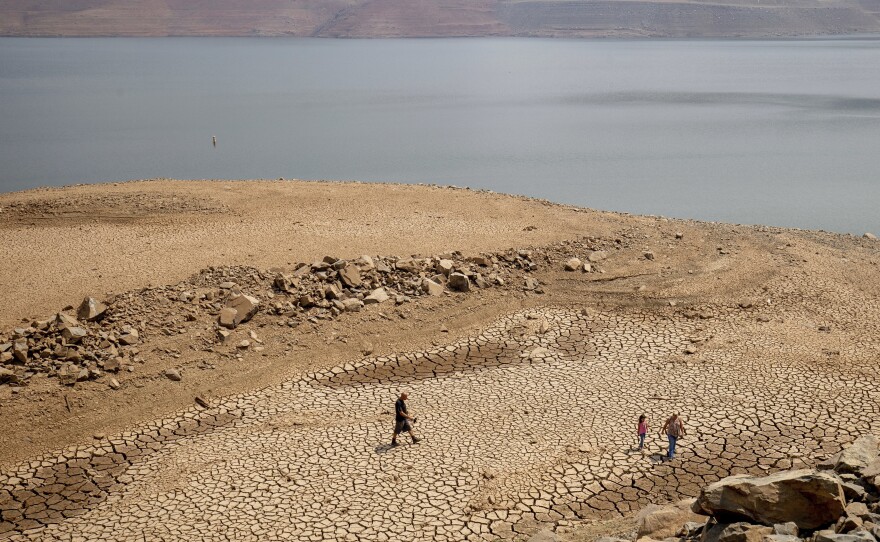California's urban water users and farmers who rely on supplies from state resevoirs will get less than planned this year as fears of a third consecutive dry year become reality, state officials announced Friday.
Water agencies that serve 27 million people and 750,000 acres (303,514 hectares) of farmland, will get just 5% of what they've requested this year from state supplies beyond what's needed for critical activities such as drinking and bathing.
That's down from the 15% allocation state officials had announced in January, after a wet December fueled hopes of a lessening drought.
But a wet winter didn't materialize and unless several more inches of rain falls this month, the January-March period will be the driest start to a California year at least a century.
“We are experiencing climate change whiplash in real time with extreme swings between wet and dry conditions. That means adjusting quickly based on the data and the science,” Karla Nemeth, director of the Califrnia Department of Water Resources, said in a statement announcing the cutback.
State water supplies aren't the only source for many of California's water agencies. But the minimal allocation means calls for conservation are likely to continue, with state and local officials urging people to take shorter showers, pack full washing machines and dishwashers, and use less water on lawns and washing cars.
Gov. Gavin Newsom, a Democrat, recently announced an $8.25 million public awareness campaign designed to encourage people to be more mindful of their water use.
So far, Californians haven't fulfilled Newsom's call for a voluntary 15% reduction in water use compared to 2020.
January's water use was up 2.6% compared to the same month in 2020, amid dry conditions and warm temperatures.
Newsom's administration hasn't enforced mandatory cutbacks, as former Gov. Jerry Brown did during the state's last drought, which lasted from 2012 to 2016.
But California Natural Resources Secretary Wade Crowfoot said recently that local or regional governments might issue their own water use curtailment orders.
“Water is a precious resource, particularly in the American West, and we have to move away from clearly wasteful practices," he said.
California is in its second acute drought in less than a decade, and scientists say the U.S. West is broadly experiencing the worst megadrought in 1,200 years, made more intense by climate change.
People adapted their water use during the state's last drought, in part by ripping up sprinkler-hungry lawns and replacing them with drought-resistant landscaping. Many of those water-saving habits stuck.
But the dry conditions that began anew in 2020 are demanding more conservation, as reservoirs such as Lake Oroville and Shasta Lake remain below historical levels and less water from melting snow is expected to trickle down the mountains this spring.
Current predictions estimate the state will have about 57% of its historical median runoff this April through July, said Alan Haynes, hydrologist in charge for the California Nevada River Forecast Center of the National Oceanic and Atmospheric Administration.
A persistent lack of water can produce a range of negative consequences, including farmers fallowing fields and endangered salmon and other fish dying.
The water providers that rely on state supplies have a certain amount they of water they can request from the state, and the state makes determinations through the winter on how much they will get based on supply.
In December, before the major snowfall, state officials told water providers that they wouldn't get anything beyond what was needed for immediate health and safety, such as drinking and bathing. The state upped that to 15% of requested supplies in January.
“What is our plan here to sustain through what may be a very long drought? Nobody knows, and I don’t think we’re getting the miracle March that we hoped for," said Jennifer Pierre, general manager for the State Water Contractors, which represents the agencies that rely on state supplies.
She said the state needs to plan for future droughts by spending money to line canals so they don't leak and protect against water loss, improve groundwater basins and provide more financial incentives for people to make their properties more drought friendly.
Critics of California's water policy say the larger problem is that the state promises more water each year than it has to give. That's led to a continued diminishment of supply in federally and state run reservoirs, said Doug Obegi, an attorney focused on water for the Natural Resources Defense Council.
“We basically have a system that is all but bankrupt because we promised so much more water than can actually be delivered," he said.
Officials on Friday also announced a plan to seek a temporary exemption from water quality requirements in Northern California's Delta, the part of the state’s watershed where the freshwater rivers and salty ocean water mingle.
That would allow the state and federal water projects to release less water into the Delta from the Shasta, Folsom and Oroville reservoirs — which are the state's major water supply sources.
The water quality standards are designed, in part, to ensure the water doesn’t get so salty it can’t be used for farming, drinking and protecting the environment.






